Uber's First Self Driving Truck Teams Up With Budweiser
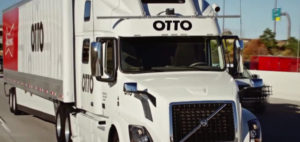 The future is now! Uber Technologies Inc. and Anheuser-Busch InBev NV have teamed up to test the joint venture’s first self-driving semi truck. Recently the company was permitted to test its driverless truck on a stretch of I-25 in Colorado. The tractor trailer was the first in history to make a commercial shipment without a driver.
The future is now! Uber Technologies Inc. and Anheuser-Busch InBev NV have teamed up to test the joint venture’s first self-driving semi truck. Recently the company was permitted to test its driverless truck on a stretch of I-25 in Colorado. The tractor trailer was the first in history to make a commercial shipment without a driver.
The tractor trailer full of 50,000 beers drove roughly 120 miles while the truck driver hung out in the back of the sleeper cab. This wasn’t some rogue incident; a team of police cruisers followed the truck throughout the entire journey and made sure the road was free of unexpected danger ahead of the vehicle. Uber worked closely with Colorado State Patrol to map out a route between Fort Collins and Colorado Springs. The trip was done in the early morning when traffic was relatively light and conditions were dry.
Uber declared the stunt a success and the truck reached its delivery destination without incident. The publicity stunt seems to stem from Uber’s recent acquisition of Otto, a self-driving technology company that Uber purchased in July of this year. The company wanted to prove to the public that they could debut a driverless vehicle of their own to compete with Google, Tesla, Freightliner and Mercedes Benz. The camera system, GPS, braking, steering module and diesel engine all worked flawlessly. Freightliner has experienced a few long-range tests on California freeways only allowing the driver to take over in more densely populated urban areas. Google was the first company to really tinker with self-driving cars; testing the vehicles in Nevada exclusively. Over the years Google has only gotten in one minor crash in a populated urban area. Not too bad for thousands of hours logged behind the wheel. Nevada is currently the only state to have legislation on the books regarding self-driving vehicles.
Freightliner has experienced a few long-range tests on California freeways only allowing the driver to take over in more densely populated urban areas. Google was the first company to really tinker with self-driving cars; testing the vehicles in Nevada exclusively. Over the years Google has only gotten in one minor crash in a populated urban area. Not too bad for thousands of hours logged behind the wheel. Nevada is currently the only state to have legislation on the books regarding self-driving vehicles.
Fully Autonomous Self Driving Vehicles
Currently, all self-driving cars have a driver in placed behind the wheel at all times but the laws have not fully caught up with the technology. It makes sense that one day self-driving cars will be fully autonomous but that will be years in the future if at all. In the past 10 years or so more computerized gadgets have become available in both on-road and off-road vehicles. Backup cameras, parking assist, emergency braking, lane change warning and intelligent cruise control are all now standard features in most new cars.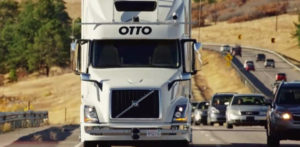
However, all of these new features only require a few seconds of computerized self-control with the driver standing by or assisting in the action. These actions are all gradual in terms of timeframe required to perform the action. For example a GPS system can plan for an exit coming up ahead or adjust to rain slicked roads.
With fully autonomous vehicles this would require the computer to be on continuously for hours on end. There is no room for error which means the guidance systems would have to be able to predict every possible crisis scenario from animals in the road, pending accidents, changing weather and road conditions etc… Each would have to be accounted for 100%. These systems would have to handle these unexpected conditions from day one in order to be safe.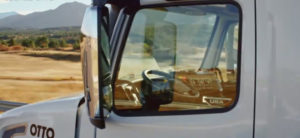 Consumers will expect the fully autonomous systems to work in every possible condition from the highway to backcountry roads to inner city streets. What this means for software developers is that very detailed maps will have to be created more so than what currently exists with GPS makers like Tom Tom or Garmin. Extremely powerful algorithms will need to be created in order to deal with real time road conditions. For example self driving cars will need to understand how to drive in 6 inches of snow on a particular stretch of road with unique traffic conditions. The car will also have to learn how to react to icy conditions and how the car will correct itself if it goes into a slide.
Consumers will expect the fully autonomous systems to work in every possible condition from the highway to backcountry roads to inner city streets. What this means for software developers is that very detailed maps will have to be created more so than what currently exists with GPS makers like Tom Tom or Garmin. Extremely powerful algorithms will need to be created in order to deal with real time road conditions. For example self driving cars will need to understand how to drive in 6 inches of snow on a particular stretch of road with unique traffic conditions. The car will also have to learn how to react to icy conditions and how the car will correct itself if it goes into a slide.
Significant Cost Savings
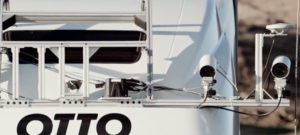 The good news is that the technology is here and is capable of evolving into a multi-billion dollar industry. Lior Ron, President of Uber’s Otto Unit stated they “…wanted to show that the basic building blocks of the technology are here…”
The good news is that the technology is here and is capable of evolving into a multi-billion dollar industry. Lior Ron, President of Uber’s Otto Unit stated they “…wanted to show that the basic building blocks of the technology are here…”
The advantages of self-driving cars, aside from the convenience factor, would be a significant cost savings for companies. AB InBev said it could save roughly $50 million per year alone in the U.S. if independently operated trucks ran freely along its distribution network. Those cost savings would come from a significant reduction in fuel costs and a more reliable and frequent delivery schedule.
Overall, companies in the trucking industry are looking to cut costs anyway they can. Making the loads lighter, cutting fuel costs or even installing governors that regulate route and speed are all ways to make over-the-road transportation more efficient.
Teala Self-Driving Car Death
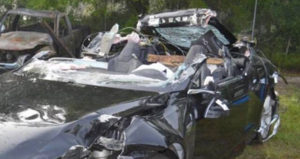 However, Americans aren't completely sold on the technology just yet. Public scrutiny over the recently Google crash as well as escalating regulation may just put the brakes on autonomous trucks on the road. The trucking industry in particular is up and arms about the technology claiming the computers could never replace the skill of an experienced driver. Being able to adapt instantaneously to changing road conditions and recognizing patterns from years of driving are just not something you can teach a machine. The U.S. Trucking industry employed 1.5 million drivers in September of this year. Many speculate the real reason truckers are not backing the technology is that these systems may one day threaten to put the driver’s jobs at risk.
However, Americans aren't completely sold on the technology just yet. Public scrutiny over the recently Google crash as well as escalating regulation may just put the brakes on autonomous trucks on the road. The trucking industry in particular is up and arms about the technology claiming the computers could never replace the skill of an experienced driver. Being able to adapt instantaneously to changing road conditions and recognizing patterns from years of driving are just not something you can teach a machine. The U.S. Trucking industry employed 1.5 million drivers in September of this year. Many speculate the real reason truckers are not backing the technology is that these systems may one day threaten to put the driver’s jobs at risk. Actress Jayne Mansfield
Actress Jayne Mansfield
In May of 2016 a driver using Tesla’s autopilot system died from the result of a crash with a semi. Joshua Brown passed away in Florida on Interstate 27A when his car struck a semi-truck that pulled onto the highway to make an abrupt turn. The smart autopilot system was engaged at the time but neither 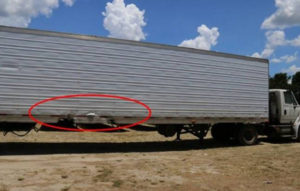 Brown nor the autopilot system registered corrective measures to prevent the crash. Brown was clocked going 74 MPH and was speeding at the time of the impact,which sliced through the top of his car. The posted speed limit on Highway 27A is 65 MPH but 9 miles over the posted limit is not an abnormal highway speed. Tesla’s vehicles have the ability to read speed limit signs and keep the car within the limit of the law however that feature is currently defaulted to "disabled" allowing the driver to go as fast as they want. Brown’s car hit the truck at a 90 degree angle, continued underneath the truck sheering off the roof and continued another 297 feet down the road before hitting a utility pole and spinning counter clockwise another 50 feet before fully stopping. At the point of impact the autopilot feature disengaged the engine but was unable to prevent the crash.
Brown nor the autopilot system registered corrective measures to prevent the crash. Brown was clocked going 74 MPH and was speeding at the time of the impact,which sliced through the top of his car. The posted speed limit on Highway 27A is 65 MPH but 9 miles over the posted limit is not an abnormal highway speed. Tesla’s vehicles have the ability to read speed limit signs and keep the car within the limit of the law however that feature is currently defaulted to "disabled" allowing the driver to go as fast as they want. Brown’s car hit the truck at a 90 degree angle, continued underneath the truck sheering off the roof and continued another 297 feet down the road before hitting a utility pole and spinning counter clockwise another 50 feet before fully stopping. At the point of impact the autopilot feature disengaged the engine but was unable to prevent the crash.
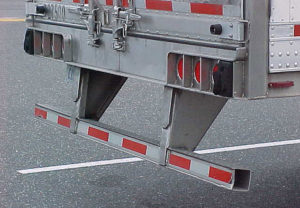 Mansfield Bar - Named After Actress Jayne Mansfield Who Died as a Result of a Semi Rear End Collision
Mansfield Bar - Named After Actress Jayne Mansfield Who Died as a Result of a Semi Rear End Collision
All trucks are required to be installed with a Mansfield Bar on the back of the tractor-trailer (Named after famous actress Jayne Mansfield who died when her car slammed into the back of a tractor-trailer and rode underneath the trailer cutting the top off the vehicle.) The semi-truck involved in the Tesla crash was not equipped with Mansfield Bars on the side of the truck which are not required in the U.S.
Increasing Political Regulation
Brown’s death brought to the forefront the uncertainty of the technology and has spurred political attention to self-driving vehicles. Regulations on both a State and National level have been introduced as topics of discussion. Only Nevada has state wide regulation in place regarding self-driving vehicles stating a driver must be behind the wheel at all times. The U.S. Department of Transportation released its official policy regarding self-driving vehicles warning the public of the dangers of “human test pilots”.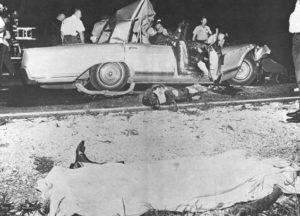 Mansfield Crash Scene - 1967
Mansfield Crash Scene - 1967
Uber stated that it does not plan to build its own fleet of trucks but would rather partner up with existing automakers as it is currently doing with Volvo on its self-driving cars. There are many potential trucking partners that are interested in the technology and discussions are in the early phases. The software still has a considerable way to go to become common place; maybe another 10 years or so. The goal isn’t to replace truck drivers entirely but rather have them supervise the rig on the highway. Statically, 95% of the hours spent on the road for tractor-trailers are on the highway.
The goal is to create safer more cost efficient ways to transport good across the country. Only time will tell what the future will hold for self-driving trucks but so far things are looking up!




